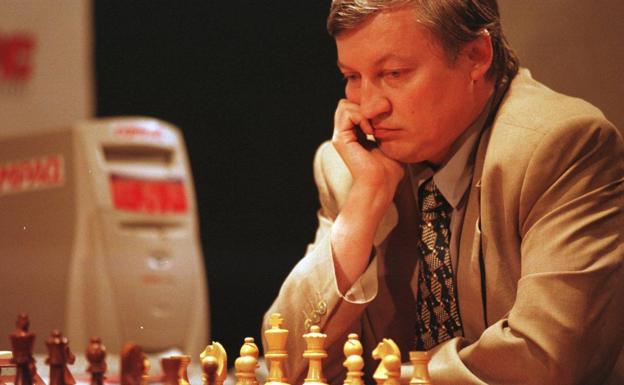MMMG #7: Sweet memories
Miguel Illescas Córdoba was born on December 3, 1965 in Barcelona. A young talent, he won the Catalonian Junior Championship at age 12, before becoming Spain’s strongest and most consistent player for a number of years. Illescas won the Spanish National Championship for the first time in 1995, and went on to repeat the feat seven more times, getting his last title in 2010. Not only was he a great practical player, but he also excelled as a theoretician, educator and promoter.
A few of his most remarkable tournament results include:
- Reaching the final of the 1993 knockout tournament in Wijk Aan Zee, losing to Anatoly Karpov to get second place after having beaten Vladimir Tukmanov, Boris Gelfand, Julian Hodgson and Lembit Oll.
- Sharing first place with Veselin Topalov at the 1996 Magistral de Madrid, a 10-player single round-robin in which he defeated Viktor Korchnoi, Michael Adams, Alexander Morozevich and Boris Gelfand.
- Sharing first place with Emil Sutovsky and Luke McShane at the 2003 Pamplona International Tournament, getting victories over Yannick Pelletier, Emil Sutovsky and Hikaru Nakamura.
As he points out in the text below, however, perhaps his most precious victories came when he worked as a coach. He was part of IBM’s team that prepared the super-computer Deep Blue to face Garry Kasparov in 1997, and then helped Vladimir Kramnik defeat the same tough opponent at the 2000 World Championship match in London.
In 1999, Illescas founded EDAMI (Escuela de Ajedrez Miguel Illescas), a flexibly-structured chess education centre in Barcelona, which also serves as a chess supplier, organizes a number of events and publishes the popular chess magazine Peón de Rey.

A photo recently shared on his Twitter account
In his most memorable game, Illescas shares his win over Anatoly Karpov at the 1999 Dos Hermanas Tournament.
Illescas, Miguel vs. Karpov, Anatoly
Dos Hermanas, 1999
After accepting ChessBase’s kind invitation to contribute to this section, I had a hard time deciding which was my most memorable game. Forty years of chess career go a long way, and I fondly remember brilliant combinations, profound strategic plans, surprising endings, curious anecdotes and decisive duels.
 Garry Kasparov's rise to the top was meteoric and at his very first attempt he managed to become World Champion, the youngest of all time. In over six hours of video, he gives a first hand account of crucial events from recent chess history, you can improve your chess understanding and enjoy explanations and comments from a unique and outstanding personality on and off the chess board.
Garry Kasparov's rise to the top was meteoric and at his very first attempt he managed to become World Champion, the youngest of all time. In over six hours of video, he gives a first hand account of crucial events from recent chess history, you can improve your chess understanding and enjoy explanations and comments from a unique and outstanding personality on and off the chess board.Despite the above-mentioned achievements, perhaps my most memorable games came when I worked as a coach: Deep Blue’s fantastic victory over Kasparov in 1997 in a Ruy López, or Vladimir Kramnik’s win against the same mighty opponent in London 2000, when he destroyed Garry’s Grünfeld Defense.
As a player, I have also been fortunate to face several world champions, from Smyslov — when he was already old but still extraordinarily strong — to Carlsen, when Magnus was a teenager in full swing. I faced Tal once, and got to play a few games with Spassky and Kasparov, while I faced Karpov, Kramnik and Anand many times, since they visited Spain regularly in the 1990s. With all of them I managed to draw at least once and lost on numerous occasions. I was able to achieve a single victory in a classic game — it was against Anatoly Karpov in 1999, in the famous Dos Hermanas Tournament. Naturally, that is the game I have chosen to comment on.
The Sevillian town of Dos Hermanas competed with Linares in the 1990s in presenting the best field each year. I fondly remember both tournaments. In my case, I always achieved better results in Dos Hermanas, maybe because the organizers took great care of me and I was almost guaranteed a place, which allowed me to play without so much pressure. Competing with the best in the world, I obtained some of the best performances of my career in that tournament.
 The La Motilla hotel, the players’ accommodation, was in a quiet residential area, and it was common to see the players strolling or jogging through the pleasant tree-lined avenues. The fact that the hotel was somewhat isolated created an intimate and cosy atmosphere, and the players and trainers used to meet at the cafeteria to chat or play cards; I remember myself playing Belote with the Russians — including Karpov himself [pictured, in 1999], who was very competitive. A very relaxed and cordial atmosphere was generated, unlike what was seen in other tournaments like Linares, in which a more aggressive atmosphere was the rule.
The La Motilla hotel, the players’ accommodation, was in a quiet residential area, and it was common to see the players strolling or jogging through the pleasant tree-lined avenues. The fact that the hotel was somewhat isolated created an intimate and cosy atmosphere, and the players and trainers used to meet at the cafeteria to chat or play cards; I remember myself playing Belote with the Russians — including Karpov himself [pictured, in 1999], who was very competitive. A very relaxed and cordial atmosphere was generated, unlike what was seen in other tournaments like Linares, in which a more aggressive atmosphere was the rule.
The game I comment on below was played in the sixth round of the 1999 tournament. I had just lost to Vladimir Kramnik in what would be my only loss of the tournament — I got a ‘correct’ fifty percent score in the end. On the other hand, Karpov was having a good event, having obtained a win and four draws. It was logical to think that Anatoly would try to take some risks in this game, since a win would have been enough for him to reach the top of the standings table. I just wanted to play solidly and recover from the fiasco of the previous day. But, as it usually happens, the game went its own way.
[You can go through the game in text format below or on the replayable board at the end of the article.]
1.e4
In several previous games, I had spoiled advantageous positions against Anatoly, so after getting ahead in the opening, I knew I couldn't let my guard down until the very end. I was lucky enough to find good moves in several key moments, particularly moves 21, 31, 36 and 40. I have to admit that this game is not particularly brilliant, but it has several interesting moments, such as the ending that occurs in the 27...e3 variation, and some positions with four queens on the board, which were extremely difficult to calculate.
1...c6 2.d4 d5 3.Nd2 dxe4 4.Nxe4 Bf5
Karpov's great specialty was always 4...Nd7 but luckily I had also prepared against the bishop's sortie
5.Ng3 Bg6 6.h4 h6 7.Nf3 Nf6
This move order was fashionable in the 80s, but later Black returned to the classic 7...Nd7; and lately they prefer 7...e6
8.Ne5
The only precedent for Karpov playing this variation followed 8.h5 Bh7 9.Bd3 Bxd3 10.Qxd3 e6 11.Bd2 Be7 12.0–0–0 Nbd7 13.Kb1 0–0 14.Qe2 c5 15.c4 cxd4 16.Nxd4 Qb6= Macieja, B-Karpov,A/Polanica Zdroj 1998 0–1 in 61 moves
8...Bh7 9.Bd3 Bxd3
A strange but playable alternative is 9...Nbd7 10.Bxh7 Nxe5 11.dxe5 Qa5+ 12.f1 xh7; Instead, it would be a serious mistake 9...Qxd4? 10.Nxf7! Kxf7? 11.Bg6+ droping the queen
10.Qxd3 e6 11.Bd2 Nbd7 12.f4
This is the most logical treatment to take advantage of the time that White has saved by not making the h4 – h5 advance: the knight on e5 is reinforced.
12...Bd6 13.0–0–0 0–0 14.Kb1
After this prophylactic move the fight is well defined: Black must break in the center before White can attack on the kingside.
14...Qc7
Leaving place for a rook. It seems early for 14...c5 because after 15.Bc3 the pressure on the d file is very strong, and the natural 15...Nd5 is answered with 16.Nh5 and after Qg3 White's attack becomes very dangerous
15.Ne2
The knight was disturbing the g2 – g4 advance, which White needs to organize the attack.
15...Rad8
Black continues with his plan. Now it is time for the white queen to move away from the d line.
16.Qf3
This was all part of my preparation, successfully carried out the night before with my coach, GM José Luis Fernández. Seems early for 16.g4?! because after 16...Bxe5 17.fxe5 Black has 17...Nxe5! 18.Qg3 Ne4! and the fight in the center comes faster than White's action on the kingside.
16...h5
An ambitious procedure to oppose the g2 – g4 advance, which Ivanchuk had used successfully against Anand just a month earlier at the Linares tournament. Black wants to dominate the square g4, even if this involves a risk by weakening his king. It doesn't work to go 16...c5 due to 17.g4! cxd4 18.Nxd7 Nxd7 19.Nxd4 followed shortly by a g5 push, with a strong attack.
17.g4!N
This move took Karpov by surprise, and if it works it will cast doubt on the value of the entire black scheme. In the aforementioned game White chose to prepare the break with 17.Rhg1 and after 17...c5! black managed to equalize 18.g4 Bxe5 19.dxe5 Nxg4 20.Ng3 f5! 21.exf6 Ndxf6 22.Nxh5 Nxh5 23.Qxg4 Rf5= Anand,V-Ivanchuk,V/Linares 1999 ½–½ in 45 moves
17...Bxe5
Some commentators recommended 17...hxg4 18.Nxg4 Nxg4 19.Qxg4 f5 but White's attack is strong after 20.Qg2! (In the post-mortem analysis Karpov pointed that he was bothered by 20.Qg5 Nf6 21.h5 but modern computers defend with 21...Ne4 22.Qg2 Nxd2+ 23.Rxd2 Bxf4 24.Nxf4 Qxf4 25.h6 Rf7 (or even 25...g5) ) 20...Nf6 21.h5 Ng4 22.h6!
Blocking the g-file is not enough to contain White's attack. In case of 22...g6 23.h7+ Kh8 White can even try 24.d5! and Black's position looks very dangerous.
18.fxe5 Nxg4 19.Nf4!
Unlike in Anand's game against Ivanchuk, the knight does not go to g3 but to f4, avoiding the f5 reply, key to Black's defense.
19...Ndxe5!
Karpov finds the best practical defense, sacrificing a knight for three pawns, to stop White's agressive intentions. 19...g6 leads to disaster after 20.Rhg1 c5? 21.Nxh5! gxh5 22.Rxg4+ with mate in a few moves.; It's also inferior to play 19...c5 20.Nxh5 f5 21.exf6 Ndxf6 22.Nxf6+ Nxf6 23.dxc5±
20.dxe5 Qxe5
Black's plan is Qf5 and e5, expelling the white knight and mobilizing his majority on the kingside. I remember that here I had to think for a while, looking for a way to give value to my extra piece.
21.Bc1!
It was necessary to remove the bishop from the black rook's file, but where? 21.Bc3 looked natural, but after 21...Qf5 22.Qg3 Rxd1+ 23.Rxd1 e5 24.Nd3 f6 Black would build an effective wall, and the activity of my pieces would be very reduced.; Very similar was 21.Bb4 c5 22.Bc3 Qf5
21...Qf5 22.Rxd8! Rxd8 23.Rd1!
With the bishop on c1 this important move is possible. Giving up the d line is not an option for black, and after the rook exchange the white queen will be able to penetrate into Black's camp
23...Rxd1 24.Qxd1 e5 25.Qd8+ Kh7 26.Nd3 [With the idea Nc5–d7–f8] 26...e4!
Passed pawns must be pushed! At the same time, the black queen controls c5. It would be wrong to go for 26...f6 27.Nc5 e4 28.Qe7! followed by Ne6 or Nd7; 26...b6 was possible, a logical attempt to stop the activity of the white knight. However, it can find another path that still works: 27.Nb4! Qe6 28.Qc7! c5 29.Nc6 e4? 30.Nd8 winning
27.Nf4 Ne5?!
Karpov misses the opportunity to advance his pawn further. After 27...e3! I had planned to exchange queens with 28.Qd3 Qxd3 29.cxd3
Like me, during the game Karpov thought that White would have a clear advantage in this ending, but there is a well hidden idea that could - perhaps - save Black: 29...g5! 30.hxg5 h4 31.Kc2 Nf2! 32.Bxe3 h3 33.Ne2 h2 34.Ng3 h1Q 35.Nxh1 Nxh1 36.Bxa7 Kg6 37.Be3 Ng3 38.Kc3 Nf5
And after the inevitable pawn swap on f6 it is not clear that White can win.
28.Qe7!
I now have a precious tempo to create direct threats.
28...b5
The passive 28...Nd7? is punished with 29.Nxh5!
29.Qxa7 Nf3
The material balance is definitely in White's favour, so Karpov uses his last chances on the kingside.
30.Qe7 c5!
The advantage is clear, but the game is far from being won. The following manoeuvre allows White to effectively block Black's passed pawn.
31.Ng2! f6! 32.Ne3±
The knight on e3 is too strong for the black pawns to give sufficient compensation. But Karpov fights back tenaciously.
32...Qe5! 33.Qd7!
With the idea of Nf5, so Black's answer is forced. I wanted to play 33.Qxe5!? Nxe5 34.c4! b4 35.a4! bxa3 36.bxa3 but 36...g5! which scared me, although the machine claims that White's advantage is clear after the cool 37.Bb2!
33...Nxh4
How well queen and knight complement each other in attack can be seen in variants such as 33...b4 34.Nf5 Kg6 35.Ne7+! Kh7 36.Qe8! and the mating net is ready.
34.Qxb5
White finally gets a passed pawn, and the action picks up speed, just when the players have little time on the clock
34...Nf5!
Karpov finds again the best defence. 34...f5 35.a4 f4 36.Nc4 and the a-pawn is faster.
35.Nxf5 Qxf5
36.b4!
In view of the strength of the h-pawn, I had to act with extreme precision. It was not sufficient 36.a4? h4 37.a5 h3 38.Qb8 (38.a6? h2 39.a7 h1Q 40.a8Q Qf4–+) 38...e3! 39.Qg3 (39.Bxe3 Qf1+ 40.Bc1 Qg1! 41.Qe8 h2 42.Qh5+=) 39...e2 40.a6 Qf1
and there is nothing better than 41.Qh4+! (41.a7? e1Q 42.Qxe1 Qxe1 43.a8Q h2) 41...Kg6 42.Qg4+ Kf7 43.Qd7+ Kg6=
36...h4 37.Qxc5 Qf3
It doesn't help Blavk to play 37...Qxc5 38.bxc5 g5 39.Be3! h3 40.Bg1 e3 41.Kc1! and the black pawns are neutralized
38.b5 h3 39.b6 e3!
If 39...h2 40.b7 h1Q 41.b8Q Black would still be a piece down, and there is no time for 41...e3 42.Qcc8 with a decisive advantage for white.
40.Qb4!
The computer confirms that this is the only move to keep the advantage, and I was lucky to reach the time control to be able to convert it without any more problems. After 40.Qc7? e2 41.b7 e1Q 42.b8Q Qfe3 43.Qb2 Q3d2 and in view of the imminent advance of the h-pawn White must look for a draw with 44.Qf7 h2 45.Qh5+ Qh6 46.Qf5+ Qg6 47.Qh3+
40...h2?
With less than 20 seconds to make his last move before the time control, Karpov finally blunders. Best was 40...e2 41.Bd2! (41.b7? e1Q 42.b8Q Qxb4+ 43.Qxb4 Qg2 44.Qh4+ Kg8 45.Bf4 g5 46.Qg3 Qf1+ 47.Bc1 Qb5+ 48.Bb2 Qf1+=) 41...Qg2 (41...Kg6 42.b7 h2 43.b8Q+–) 42.b7 h2 43.Qh4+! (43.b8Q? h1Q+ 44.Kb2 Qgf1=) 43...Kg6 44.b8Q h1Q+ 45.Qe1±
establishing a solid blockade on e1 that should guarantee victory
41.Qh4+ Kg8 42.Qxh2 e2 43.Qh4 Qc6 44.Qb4
Complications are over, and only here was I convinced that the game was totally won.
44...e1Q 45.Qxe1 Qxb6+ 46.Bb2
A full piece up, Karpov's final resistance will not alter the fate of this game.
46...g5 47.Qg3 Kh7 48.a4 Kg6 49.Qb3 Qg1+ 50.Ka2 Qc5 51.Qg8+ Kf5 52.Qh7+ Kf4 53.Qh2+ Kf5 54.Qh7+ Kf4 55.Qd3 Qc6 56.Qd4+ Kf5 57.Qd3+ Kg4 58.Kb3 Qb6+ 59.Qb5 Qe3+ 60.Bc3 f5 61.a5 f4 62.Qb6 Qe4 63.a6 f3 64.Qd4 1–0
On this DVD a team of experts looks closely at the secrets of Karpov's games. In more than 7 hours of video, the authors examine four essential aspects of Karpov's superb play.
Links



















 The La Motilla hotel, the players’ accommodation, was in a quiet residential area, and it was common to see the players strolling or jogging through the pleasant tree-lined avenues. The fact that the hotel was somewhat isolated created an intimate and cosy atmosphere, and the players and trainers used to meet at the cafeteria to chat or play cards; I remember myself playing Belote with the Russians — including Karpov himself [pictured, in 1999], who was very competitive. A very relaxed and cordial atmosphere was generated, unlike what was seen in other tournaments like Linares, in which a more aggressive atmosphere was the rule.
The La Motilla hotel, the players’ accommodation, was in a quiet residential area, and it was common to see the players strolling or jogging through the pleasant tree-lined avenues. The fact that the hotel was somewhat isolated created an intimate and cosy atmosphere, and the players and trainers used to meet at the cafeteria to chat or play cards; I remember myself playing Belote with the Russians — including Karpov himself [pictured, in 1999], who was very competitive. A very relaxed and cordial atmosphere was generated, unlike what was seen in other tournaments like Linares, in which a more aggressive atmosphere was the rule.




